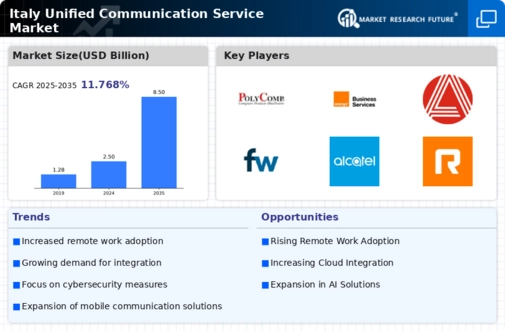The unified communication-service market in Italy is characterized by a dynamic competitive landscape, driven by rapid technological advancements and an increasing demand for integrated communication solutions. Major players such as Microsoft (US), Cisco (US), and Zoom (US) are at the forefront, each adopting distinct strategies to enhance their market presence. Microsoft (US) focuses on continuous innovation, particularly through its Teams platform, which integrates various communication tools into a single interface. Cisco (US), on the other hand, emphasizes partnerships and acquisitions to bolster its offerings, while Zoom (US) is expanding its services to include more comprehensive solutions for businesses, thereby enhancing its competitive positioning.
The market structure appears moderately fragmented, with several key players vying for dominance. Companies are increasingly localizing their operations and optimizing supply chains to better serve the Italian market. This localized approach not only enhances customer satisfaction but also allows for more agile responses to market demands. The collective influence of these major players shapes a competitive environment where innovation and customer-centric strategies are paramount.
In September 2025, Microsoft (US) announced a significant upgrade to its Teams platform, introducing advanced AI-driven features aimed at improving user experience and productivity. This strategic move underscores Microsoft's commitment to maintaining its leadership position by leveraging cutting-edge technology to meet evolving customer needs. The integration of AI capabilities is likely to enhance collaboration and streamline workflows, positioning Microsoft favorably against its competitors.
In October 2025, Cisco (US) completed the acquisition of a prominent Italian communication software firm, which is expected to enhance its service portfolio and expand its footprint in the region. This acquisition reflects Cisco's strategy to strengthen its market position through targeted investments, allowing it to offer more tailored solutions to local businesses. Such strategic actions may enable Cisco to capture a larger share of the market by addressing specific regional demands more effectively.
In August 2025, Zoom (US) launched a new suite of enterprise solutions designed to facilitate hybrid work environments. This initiative is indicative of Zoom's response to the changing workplace dynamics, as it seeks to provide comprehensive tools that cater to both remote and in-office employees. By focusing on hybrid solutions, Zoom is likely to attract a broader customer base, enhancing its competitive edge in the unified communication-service market.
As of November 2025, current trends in the market include a strong emphasis on digitalization, sustainability, and the integration of AI technologies. Strategic alliances among key players are increasingly shaping the competitive landscape, fostering innovation and collaboration. Looking ahead, it appears that competitive differentiation will evolve, with a shift from price-based competition to a focus on technological innovation, reliability, and supply chain efficiency. Companies that prioritize these aspects are likely to thrive in an increasingly complex market.



















Leave a Comment